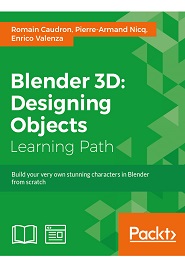
English | 2016 | ISBN: 978-1-78712-719-7 | 1281 Pages | PDF | 50 MB
Build your very own stunning characters in Blender from scratch
Blender is a powerful, stable tool with an integral workflow that will allow you to understand 3D creation with ease. With its integrated game engine and use of the Python language, it is an efficient choice for many productions, including 3D animated or live action films, architecture, research, and even game creation. Blender has an active community that contributes to expanding its functionalities. Today, it is used in many professional products and by many companies.
Throughout Blender for Designers, you will create many types of complete projects using a step-by-step approach. Start by getting to know the modeling tools available in Blender to create a 3D robot toy, and discover more advanced techniques such as sculpting and retopology by creating an alien character.
Move on in the second module to engage with the workflow used to create characters. Run through the process from modeling to the rendering stages, usi
The last module will teach you how to utilize the power of the Blender series to create a wide variety of materials, textures, and effects using the Cycles rendering engine. You will learn about node-based shader creation, and master Cycles through step-by-step, recipe-based advice. Start small by rendering the textures of stones and water, then scale things up to massive landscapes of mountains and oceans.
This Learning Path combines some of the best that Packt has to offer in one complete, curated package. It includes content from the following Packt products:
- Blender 3D By Example By Romain Caudron and Pierre-Armand Nicq
- Blender 3D Cookbook By Enrico Valenza
- Blender Cycles: Materials and Textures Cookbook – Third Edition By Enrico Valenza
What You Will Learn
- Understand the basics of 3D and how to navigate your way around the Blender interface
- Discover the power of the texture paint tool in order to add color to a haunted house
- Get to know the Cycles render engine by creating different materials for the house and the environment
- Find the best possible flow for your edge-loops to enhance the character features and to get the best possible range of deformation
- Create a basic mesh depicting the character’s overall shape and mood in a few simple steps
- Use your sculpting skills to carve the character features from the mesh
- Paint your character to enhance the surface’s details
- Mix both the Blender Internal and Cycles rendering engines in order to render materials as quickly as possible
- Set up light sources and world global illumination
- Build material interfaces for general use in complex materials by grouping the shaders inside groups
- Parent and rename the nodes to better organize the Node Editor window
Resolve the captcha to access the links!